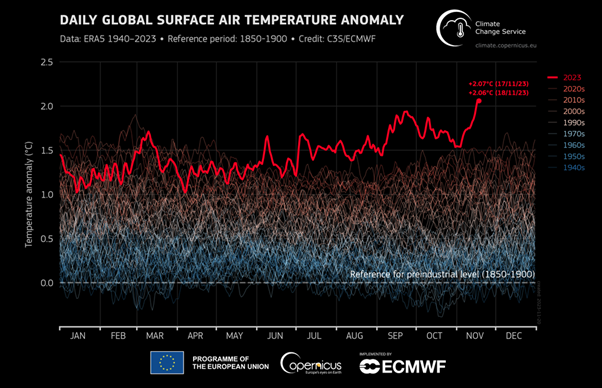There were no alarm bells. It was an ordinary Friday for most people, but a special one for us at Waste Warriors, a non-profit organisation in the Indian Himalayan region.
It was our 11th Foundation Day and we were marking it with fun and games with our 200-member team in Dehradun, a town at the foothills of the mountains in the northern state of Uttarakhand. And yet 17 November 2023 was not an ordinary day. It was the day on which ‘the global temperature exceeded 2°C above pre-industrial levels‘.
The data has long been coming, and was, perhaps, be an omen to the world’s most influential and powerful leaders as they deliberated in UAE at COP28 in December. The annual gathering steered a global agreement to keep planetary temperature rise this century well below 2 degrees Celsius above pre-industrial levels.
The pathway to achieving this goal lays emphasis on phasing out fossil fuels in an attempt to reduce carbon from the atmosphere. Over the past few years, ‘decarbonisation through technology’ has been widely considered as the only magic bullet solution to this global existential crisis. This has been the dominant theme in major climate events worldwide, two of which I had a chance to attend this year: the TED Countdown Summit on Climate Change in Detroit in July and the New York Climate Week in September. To bring global attention to this emergency situation, the complex environmental crisis has been overtly simplified and reduce to one number – 1.5 degrees Celsius.
Over the years, an overemphasis on average global temperature at the cost of other environmental indicators has led to problematic notions of solutions, such as carbon capture and offsets, that are increasingly being called out for being ‘illusions’ or ‘greenwashing’. The single-minded focus on carbon reduction has led to the ‘carbon tunnel vision’. While there is no doubt that addressing carbon in the atmosphere is an important part of the climate puzzle, a pertinent question to ask is whether we might be left with a habitable planet even if we were to somehow magically remove all excess carbon from the atmosphere.
There are calls emerging from several quarters to broaden the notion of environmental sustainability to include quality of natural assets such as air, soil and water. We need to consider the health of all species on earth during solution design, not just human health. Doing so would not only pave the way for wider climate action efforts but also spotlight other hidden existential crises, to ensure we are not too late in measuring or acting on those fronts.
A new narrative
Narratives are powerful tools that visibilise little-known and/or neglected realities. Over time, narratives shape our understanding of complex dilemmas and problems, and by extension, define our approach to their solutions. The prevailing climate narrative, which focuses on carbon and other greenhouse gas emissions, has led the world to make commitments on capping emissions and chart out net-zero futures. The imperative now is to broaden the climate narrative for a collective global acknowledgement of the wider environmental distress, and for solutions to emerge.
One such holistic climate narrative seeks to comprehend climate as an intersectional challenge and seeks to view the environment as a mosaic of interconnected elements. This articulation recognises the complex interplay of factors influencing environmental and climate health from the lens of the place. This entails examining our places not just by the impacts of excess carbon, but also the quality of air, water, soil, biodiversity and habitats to understand how these elements impact aspects of modern life via food and nutrition; health and (physical, mental & emotional) well-being; education, skill and knowledge; materiality and wasteful consumption of resources, livelihoods and manufacturing and so on.
For instance, in the ecologically fragile Himalayan landscape, dozens of villages and towns face threats of depleting water, unstable weather for agriculture and significant waste pollution. Does solving for carbon address water scarcity or deal with the implications of microplastics in soil and rivers? Is there a graph such as the Keeling Curve for the concentration of microplastics in water, and what the permissible limits are, and to know if we have already crossed those limits?
The population of the wild is declining rapidly such that humans and domesticated mammals now weigh 16 times more than all wild land and marine animals put together according to a report published in the ‘Proceedings of the National Academy of Sciences’. Do we understand the long-term implications of this on our survival as a specie?
These are just a couple of examples of the need to address interconnected challenges beyond carbon emissions. There are dozens of questions surrounding planetary threshold limits that we are yet to fully acknowledge and start finding solutions for. Diverse narratives to understand the environmental crisis in the philanthropic networks, media houses and impact investors will encourage a much greater diversity of grassroots organisations and solutions. This is an opportunity for all stakeholders, especially for climate action leaders, to re-think existing paradigms and frameworks.
Several philanthropic organisations such as the Rainmatter Foundation, a Bangalore-based climate action fund, seek to address interconnected challenges beyond carbon emissions. Their place-based approach to resilience takes into account local biodiversity, livelihoods and entrepreneurship with value creation that does not drain/extract local resources and augments the local economy while ensuring that the local communities are equipped to take onus of their place.
This is one attempt to move out of carbon silos. Funders, irrespective of whether they back youth movements or clean air campaigns or conservation efforts, can embrace a wider, more-holistic environmental lens to ask if carbon is the sole culprit or are we aiming for places that are more livable for all, respecting nature and redefining ‘development’ & our lifestyles.
Vishal Kumar is the CEO Waste Warriors Society, a social enterprise solving the waste crisis in the Indian Himalayan Region.
Marisha Thakur is the Marketing Communications Specialists, at The Rainmatter Foundation





Comments (0)